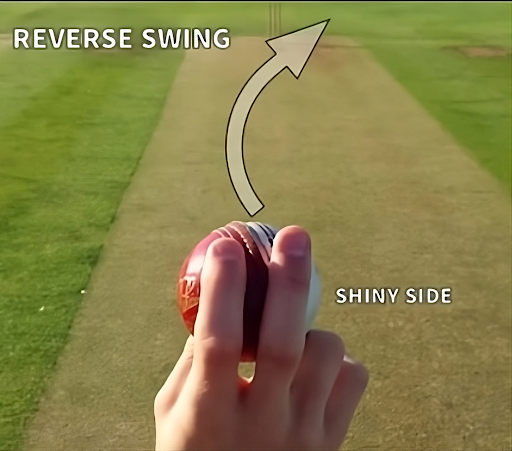Reverse Swing in Cricket: The Game-Changing Skill Every Bowler Needs
Reverse swing is one of the most effective weapons in a fast bowler’s arsenal. When used correctly, it can change the course of a game, making even the most confident batsmen second-guess their shots. But what exactly is reverse swing, and why is it so important in modern-day cricket?
In this article, we’ll break down everything you need to know about reverse swing and how you can master this game-changing skill.
What Is Reverse Swing in Cricket?
Reverse swing is a type of swing bowling that occurs when the cricket ball moves in the opposite direction to what the batsman expects, particularly when the ball is old. Unlike conventional swing, which occurs when the ball swings toward the shiny side, reverse swing happens when the ball swings toward the rough side. This late movement makes reverse swing a powerful tool for fast bowlers, especially when the ball is past its prime.
Reverse swing is typically most effective at speeds over 85 mph (137 kph). When a fast bowler can generate reverse swing, it can leave batsmen baffled and struggling to score, making it one of the most important techniques a bowler can develop.
Also Read : Different Types Of Bowling
Why Is Reverse Swing Important for Fast Bowlers?
Reverse swing is a game-changer because of its unpredictability. Unlike conventional swing, which is easier for batsmen to read, reverse swing happens late and often in the opposite direction. Here’s why reverse swing is so valuable for fast bowlers:
- Late Movement: Reverse swing occurs later in the delivery, typically when the ball is old, making it harder for batsmen to judge. This late movement catches the batsman off guard, often resulting in mistakes or dismissals.
- Deceptive: Since reverse swing doesn’t follow the normal pattern of swing (shiny side out), batsmen find it harder to predict the ball’s movement. This unpredictability is a huge advantage for fast bowlers.
- Effectiveness in the Final Stages: In the latter stages of an innings, when the ball starts to lose its shine, reverse swing can be a game-changing weapon. As the ball becomes older, the rough side wears down, providing ideal conditions for reverse swing to come into play.
- Dominance in the Air: Reverse swing allows the bowler to control the ball in the air and force batsmen into defensive positions. With the right technique, reverse swing can be as effective as seam or spin bowling, making it a versatile skill in any fast bowler’s toolkit.
Also Read This : How to Swing the Ball: A Step-by-Step Guide
How Reverse Swing Works: The Science Behind It
To understand how reverse swing works, we need to consider the dynamics of the ball’s movement through the air. A cricket ball is asymmetrical, with one side shiny and the other rough. This difference in surface texture creates an imbalance in air pressure as the ball moves through the atmosphere.
1. The Shiny and Rough Sides of the Ball
The smooth, shiny side of the ball creates less air resistance, allowing it to move more freely. Meanwhile, the rough side of the ball, which is uneven, causes more turbulence in the air. When a bowler uses reverse swing, the ball swings toward the rough side instead of the shiny side. This happens because:
- Air Flow: The smooth side experiences less drag, so it moves with the air more easily.
- Turbulence: The rough side creates more air resistance, causing the ball to move toward it.
2. High Speeds and Late Movement
For reverse swing to occur, the ball must be bowled at high speeds, typically above 85 mph (137 kph). At these speeds, the air pressure differences between the rough and smooth sides become significant enough to cause the late swing. The ball doesn’t move immediately after delivery; instead, it moves in the opposite direction in the latter part of its flight, often at the last minute. This late movement is what makes reverse swing so effective and difficult for batsmen to play.
How to Master Reverse Swing
Mastering reverse swing isn’t easy, and it requires a combination of skills, ball management, and understanding of the conditions. Here are the key factors that will help you develop the skill of reverse swing:
1. Ball Condition Is Key
The condition of the ball plays a major role in generating reverse swing. A rough ball is needed for reverse swing to work effectively. Fast bowlers often focus on maintaining one side of the ball (the shiny side) while wearing down the other side (the rough side) through consistent use.
- Shiny Side: Polishing the ball with your clothing or saliva can help maintain the shine on one side. This keeps the ball aerodynamically favorable for conventional swing early on.
- Rough Side: The rough side is what creates the necessary conditions for reverse swing. It’s often produced by natural wear and tear or by deliberately rubbing the ball against the ground or clothing.
2. Speed and Seam Position
For reverse swing to be effective, you need to bowl at high speeds, typically over 85 mph. The higher the speed, the more pronounced the effect of reverse swing. The seam position also plays a role in the direction of swing. The seam should be pointed towards the slips or gully fielders, with the rough side facing the batsman. This positioning will help the ball swing late and in the desired direction.
3. Wrist and Seam Control
To achieve reverse swing, controlling the wrist and seam is crucial. You need to maintain a firm wrist to direct the seam at the correct angle. Your wrist action should guide the ball to swing toward the rough side. Over time, with consistent practice, you’ll develop better control over the seam, allowing you to perfect the late movement that defines reverse swing.
4. Practice and Patience
Like any other skill in cricket, mastering reverse swing requires a lot of practice. Not only do you need to get the ball’s condition right, but you also need to develop the muscle memory to bowl at high speeds and with the correct wrist action. It’s a skill that takes time and dedication to perfect.
Tips for Fast Bowlers to Improve Their Reverse Swing
- Control the Shine: Regularly polish the shiny side of the ball to ensure it remains smooth. This helps create a greater contrast between the rough and shiny sides, facilitating reverse swing.
- Increase Speed: Work on increasing your bowling speed. Reverse swing is most effective when the ball is bowled at speeds over 85 mph. However, don’t compromise your accuracy for speed—practice both simultaneously.
- Experiment with Seam Angles: Try different seam angles to see how they affect the ball’s movement. A slight change in seam position can make a big difference in how much reverse swing you get.
- Watch and Learn from the Experts: Study bowlers who are known for their reverse swing, such as Wasim Akram, Dale Steyn, or James Anderson. Observe their techniques and try to incorporate elements of their bowling style into your own game.
- Understand Pitch Conditions: Learn to read the pitch and understand when reverse swing is most likely to happen. Dry, abrasive pitches are ideal for reverse swing, while wet or grassy pitches may delay its effectiveness.
Reverse swing is a skill that can make any fast bowler a match-winner. By understanding how it works and practicing the key techniques, you can add this deadly weapon to your bowling arsenal. With time, patience, and dedication, mastering reverse swing can take your game to the next level.
FAQs About Reverse Swing in Cricket
What is reverse swing in cricket?
Reverse swing occurs when the ball moves toward the rough side instead of the shiny side, especially when the ball is old and bowled at high speeds.
How does reverse swing happen?
Reverse swing happens due to the difference in air pressure caused by the smooth and rough sides of the ball. The rough side creates more drag, causing the ball to swing toward it.
Can reverse swing be mastered by all bowlers?
Yes, all fast bowlers can potentially master reverse swing with the right technique, practice, and understanding of ball condition, speed, and wrist action.
When does reverse swing become most effective?
Reverse swing is most effective when the ball is older and has a noticeable rough side, typically in the later stages of an innings.
Why is reverse swing so hard for batsmen to play?
Reverse swing is hard to play because it moves late in the delivery and in the opposite direction to what the batsman expects, making it difficult to judge and react to in time.














Post Comment